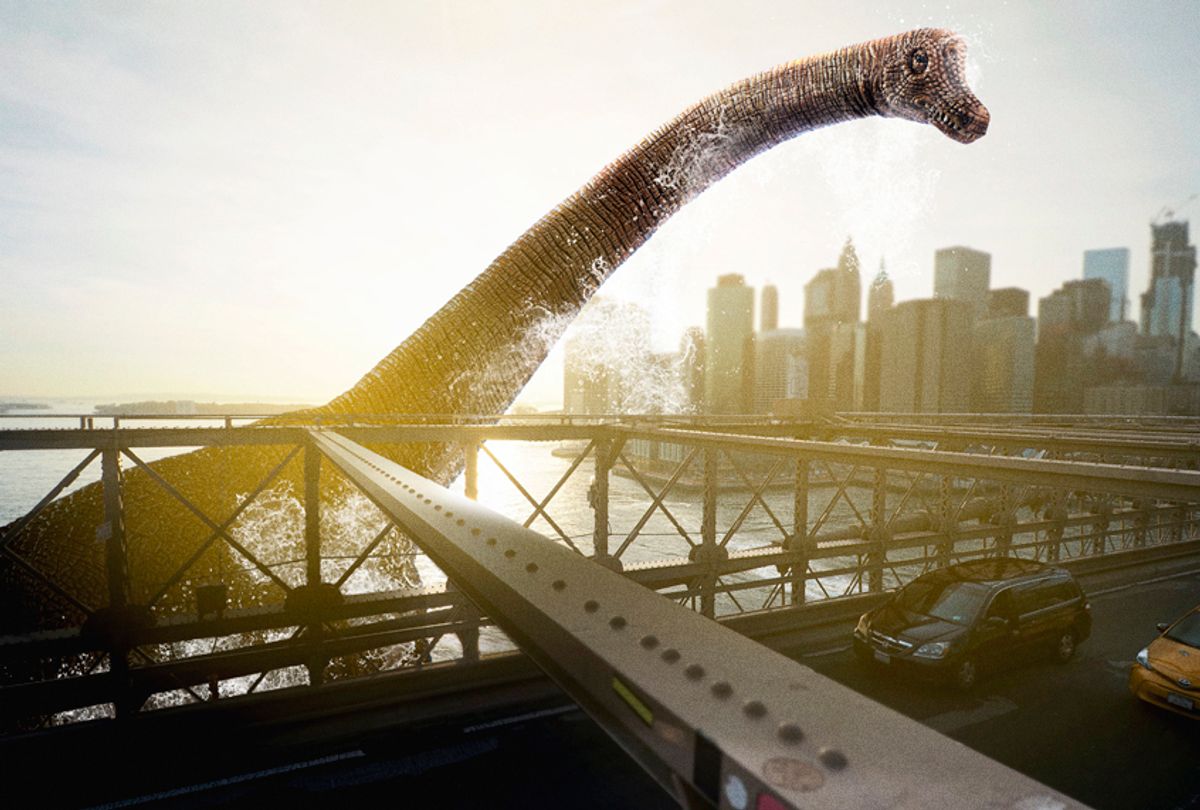As excitement builds for the just-released "Jurassic Park" sequel, sure to be a summer blockbuster, I am drawn back to the most magical scene in the original film. The paleontologist, played by Sam Neill, has just arrived on the mysterious island, still confused as to why he is even there. He is whisked around in an open-top jeep, which suddenly stops in a clearing. Hands shaking, Neill removes his sunglasses and his wide eyes focus on something high on the horizon. A low roar bellows, and a pot-belled behemoth ambles across the screen, its graceful neck reaching several stories into the canopy. As the Jurassic Park theme tune starts to play, Neill staggers toward the creature. “It’s…it’s a dinosaur,” he fumbles, left almost speechless at his first glimpse of a living version of the fossilized beasts he has spent his career studying.
When I first saw "Jurassic Park" as a 9-year-old, back in the summer of 1993, this was the scene that brought dinosaurs to life in a way that none of my schoolbooks ever could. A quarter century later, it moves me for a different reason, because now I’m a paleontologist. I’ve spent years on dig sites and in the bowels of museums, collecting and measuring and studying bones, trying to use these meager clues to decipher what dinosaurs were like as real growing, moving, breathing animals tens of millions of years ago. How would I react if a flesh-and-blood dinosaur suddenly appeared before me?
It would, I admit, be very improbable. Dinosaur cloning remains a science-fiction fantasy, as not a single fragment of fossil dinosaur DNA has ever been discovered, despite the efforts of hordes of scientists. If it somehow did happen, though, no doubt I would be as dumbstruck as Neill’s character, and intoxicated by the opportunity to see whether our theories about dinosaurs are correct.
Did Allosaurus really hatchet its prey to death with agape jaws? Would a Stegosaurus use its gaudy back plates to woo mates? Was the great T. rex actually covered in mangy feathers? How could a long-necked sauropod like Patagotitan — the size of a Boeing 737 — lay eggs and take care of its young? My list of questions would be endless.
With that in mind, what I’m about to say next may sound like sacrilege. Despite the temptation of watching a Velociraptor chase down its prey or a herd of Brontosaurus thunder across the plains, I would not resurrect dinosaurs. If there was a magical button that would deliver a real-life dinosaur, I wouldn’t push it.
Of course, on a practical level, I much prefer a world where I don’t need to worry about a T. rex stalking me as I cycle home from work or shop at the mall. I’m also partial to the philosophical treatise that because "nature" killed the dinosaurs with the wallop of a six-mile-wide asteroid, more than 60 million years before the first hominid stood up on its hind legs, it would be the height of human hubris to bring them back.
But there are two arguments that really sway me.
First, bringing back T. rex and Triceratops would, I believe, simply be cruel. They lived during the end-Cretaceous period, some 70-66 million years ago, when the world was a much different place. It was considerably warmer, there were no ice caps, sea levels were high and the oceans lapped far onto the land, and the continents were in other positions. Dinosaurs would have breathed different air (there was much more carbon dioxide in the atmosphere then), eaten different food (grasses and flowers had just started to evolve, and there were none of the grasslands or vast flowering forests of today), and interacted with different animals (mammals were little more than ratty creatures scurrying in the shadows).
Could a T. rex, which evolved in this time and place, even be able to survive in our modern world? It would be like a human trying to make it on Venus.
Second, and putting all ethics aside, we don’t really need to bring back T. rex and its Cretaceous (or Jurassic) kin if we want to be inspired by real, living dinosaurs among us. We should not lose sight of one of the most astounding facts ever discovered by paleontologists: dinosaurs are still here, in the guise of birds. Birds evolved from dinosaurs, which makes them dinosaurs. They have dinosaur DNA in their bodies, dinosaur blood running through their veins, and many of them echo their dinosaur ancestors in the way they hunt with their talons, protect their nests, fight their rivals over territory, wield their flamboyant feathers to attract mates, and use their big brains and keen senses to navigate.
Chickens, ostriches, turkeys, eagles and the other 10,000+ birds of today are every bit as "dinosaur" as T. rex or Triceratops — and they already are an integral part of our world. Let’s focus on appreciating and conserving them, rather than with the wild notion of raising T. rex from the dead.
Steve Brusatte is on the faculty of the University of Edinburgh and author of the new book "The Rise and Fall of the Dinosaurs," which tells the story of dinosaur evolution from origins to extinction and tales of the women and men around the world piecing together this story.



Shares